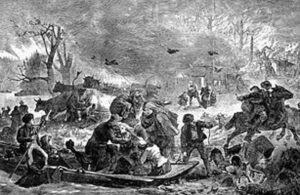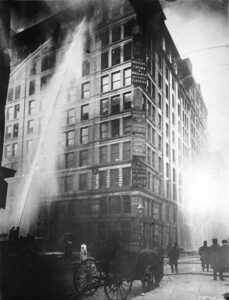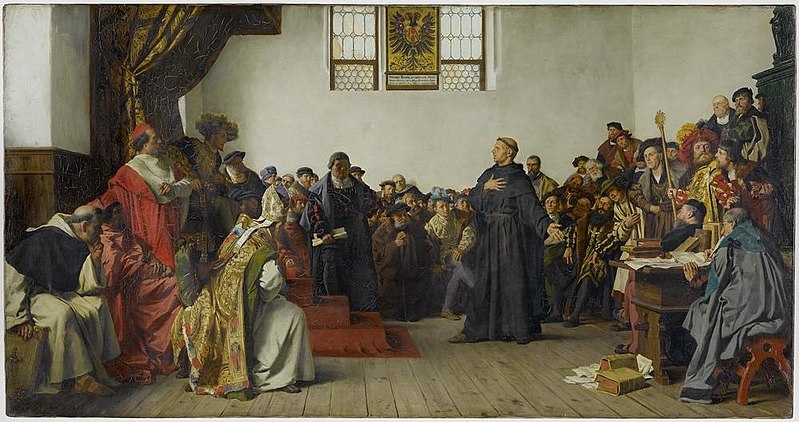The fourth year of Concerning History has come to a close, and in what has officially become our longstanding tradition, our indomitable staff reflected on the noteworthy anniversaries that have come and will come this year. As always, we can only expose the tip of the iceberg here, so if there are any commemorations we couldn’t discuss, feel free to add your own in the comments below!
1521: Martin Luther’s Excommunication
Francis Butler
Five hundred years ago Martin Luther’s criticisms of Catholic theology were transmogrified into the Protestant Reformation as Pope Leo X, the head of the Roman Catholic Church, excommunicated Luther. During the Renaissance, the Roman Catholic Church’s hegemony in Western Europe coincided with a certain practice of selling “get into Heaven free” passes (indulgences) to wealthy patrons who helped fund the construction of St. Peter’s Basilica. Martin Luther, an erstwhile academic monk, criticized this practice and argued that God can only be encountered in Scripture and salvation can only come through faith in the Resurrection of Jesus, not buying indulgences or even practicing the Sacraments. Ordered to remain silent by Pope Leo, Luther intensified his criticisms and a certain level of egoism consumed these two men in their rivalry until Christians were divided into Protestant and Catholic factions. Once Pope Leo expelled Luther, Luther promptly burned the Pope’s writ of excommunication and this theological debate descended into a century of warfare between Protestant and Catholic coalitions in Europe. Today, notions of religious liberty exist as a response to the devastation of these Wars of Religion. Nevertheless, division remains despite many ecumenical efforts to repair the damage done by Protestants and Catholics to one another.
Recommended Reading: The Reformation: A Very Short Introduction, by Peter Marshall

1871: Great Lakes Fires
Jeffrey Lauck
Wildfires are a deadly seasonal reality for millions of Americans who live in the Western states today, with fires burning hotter, igniting more frequently, and scorching larger areas as a result of changing weather patterns and desertification that come with climate change. It may come as a surprise, then, that the deadliest wildfire in U.S. history occurred not in Oregon or California, but a century and a half ago this October in the usually cool and humid Great Lakes region. An unusually dry summer turned the heavily forested rural areas and cities like Chicago constructed primarily of wooden structures into tinder. On October 8, a cold front swept through the region, bringing incredibly windy conditions that caused fires initially started to clear forests or dispose of logging debris to burn out of control. Millions of acres burned across northeast Wisconsin near the town of Peshtigo and the Door Peninsula. In Michigan, the Peshtigo fire spread to the Upper Peninsula while other firestorms engulfed portions of Western Michigan and the “Thumb” Region as well as southwestern Ontario. Sand melted into glass. A Civil War veteran who survived the fires said the roar of the flames was 100 times greater than any artillery bombardment he endured during the war. The Peshtigo fire alone burned an area 50% larger than Rhode Island and killed as many as 2,500, making it the deadliest fire event in U.S. history. Entire towns and villages were destroyed. At the same time in Chicago, a lantern that may or may not have been kicked over by the O’Leary family cow ignited a conflagration that swept through the city. The fire killed 300 Chicagoans, left over 100,000 homeless, and caused damages worth approximately $4.7 billion in 2020 currency.
Recommended Reading: Firestorm at Peshtigo: A Town, Its People, and the Deadliest Fire in American History, by Denise Gess and William Lutz

1871: Franco-Prussian War and German Unification
Bryan Caswell
One hundred and fifty years ago saw the end of one of the defining conflicts of European, and indeed world, history. While the Franco-Prussian War itself was a relatively minor affair, caused by diplomatic posturing and lasting barely longer than 6 months, its reverberations and historical significance can hardly be overestimated. Intent on regaining its primacy on the Continent after Prussia’s stunning victory over Austria in 1866, France entered an ill-advised conflict with their adversary (possibly manipulated into doing so by Prussian Chancellor Otto von Bismarck). Using the situation to Prussia’s advantage, Bismarck used the conflict to draw the remaining South German states into an alliance as Prussia’s military steamrolled the French at the battle of Sedan. In January of 1872, France was forced to sign a humiliating treaty in the Hall of Mirrors at their very own Versailles, watching as the Prussians capitalized on their triumph by declaring a united German nation. France ceded the provinces of Alsace and Lorraine to the new nation as well as punitive war reparations, slights they would remember nearly fifty years later when dealing with a defeated Germany after the First World War. The new German Kaiserreich irrevocably disrupted the balance of the Concert of Europe, inspiring the Scramble for Africa and heightened global rivalries over its new imperial ambitions (contrary to Bismarck’s recommendations), realigning European alliances, driving militarism and arms races on land and sea, and ultimately triggering the Great War itself through its recklessly aggressive diplomacy.
Recommended Reading: Iron Kingdom: The Rise and Downfall of Prussia, 1600-1947, by Christopher Clark

1911: Triangle Shirtwaist Factory Fire
Heather Clancy
In New York City on March 25, 1911, flames broke out at the Triangle Shirtwaist Factory. As word of the fire spread through the three floors of the factory, hundreds of young female workers scrambled for exits locked by foremen. Too many bodies and too few exit routes made for a deadly tragedy: by the time the fire was suppressed, 146 employees—mostly Jewish and Italian immigrants—had died, engulfed by flames or killed upon impact after desperately flinging themselves from the eighth-, ninth-, and tenth-story windows of the building. With no sprinklers or fire escapes and too-short fire engine ladders below, the building condemned its young workers to torturous deaths. The fire sent shockwaves through the labor rights movement, and many of today’s workplace safety laws are in place as a direct result of the tragedy. As we look back on the Triangle fire from our 2021 vantage point, it’s impossible not to reflect on the work that still lies before us when it comes to improving workplace conditions and safety. I hope we all take a moment to consider what’s still left to learn from this tragic loss of life 110 years ago.
Recommended Reading: “Why The Triangle Shirtwaist Factory Fire Still Burns Hot Today,” by Amy Feldman

1956: Suez Crisis
Kevin Lavery
No, not the boat story, although the more recent crisis drew attention to the enduring importance of the Suez Canal for global trade. In the wake of the Second World War, as fragmented empires began to give way to the bipolar world order of the Cold War, Egyptian President Gamal Abdel Nasser made the decision to nationalize the canal. His decision prompted an Israeli invasion backed by Britain and France, which then used the disturbance to justify sending their own forces. The two colonial powers were blindsided when their ally, the United States, officially condemned the invasion and applied pressure to cease the operation. The moment was a blow to the European empires, which had controlled the region since the end of the First World War. With American engagement in the region once again at a crossroads–between the uncertain future of the Iran deal, the growing influence of the Gulf states, and the increasing illiberalism of the Israeli prime minister–the crisis is worth revisiting as we consider America’s long-term interests over short-term expediency.
Recommended Reading: Eisenhower 1956: The President’s Year of Crisis — Suez and the Brink of War, by David Nichols
